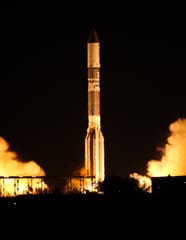Latest News
[Via Satellite 09-30-13] International Launch Services (ILS) has successfully placed the Astra 2E satellite into a geosynchronous transfer orbit (GTO) for SES. The satellite, which was manufactured by Astrium, was built on the Eurostar E3000 platform. This marks the 23rd SES satellite and the 17th Astrium satellite launched onboard an ILS Proton.
The Astra 2E satellite took off from Baikonur Cosmodrome on Sept. 29 at 5:38 p.m. EDT. The first three stages of the ILS Proton vehicle used a standard ascent profile to place the orbital unit (Breeze M upper stage and the Astra 2E satellite) into a sub-orbital trajectory. The Breeze M then performed planned mission maneuvers to advance the orbital unit first to a circular parking orbit, then into an intermediate orbit, followed by a transfer orbit, and finally to GTO. Successful separation of the Astra 2E satellite occurred exactly 9 hours, 12 minutes after liftoff.
Weighing approximately 6 tons at liftoff, Astra 2E will have a wingspan of 40 meters (approximately 131 feet) once its solar arrays are deployed in orbit, and a spacecraft power of 13kW at the end of its 15-year design lifetime. The satellite is equipped with 60 Ku-band transponders, and four Ka-band transponders that include one interconnect. Its final orbital arc will be 28.2/28.5 degrees east longitude from there the satellite will deliver high-performance direct-to-home (DTH) and next-generation broadband services to Europe, the Middle East and Africa.
Get the latest Via Satellite news!
Subscribe Now